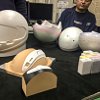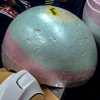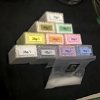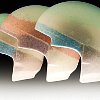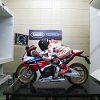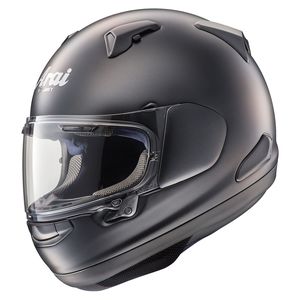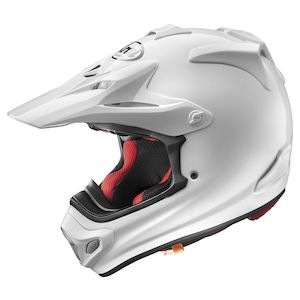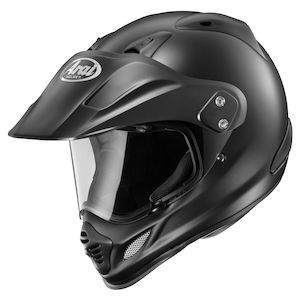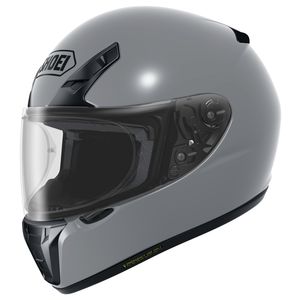One of the questions we constantly hear at RevZilla is “What’s the difference between X and Y?” Most often, customers solving for X and Y are asking about what sets Arai and Shoei apart from one another.
Despite all of the changes and technological innovations over the past decade, Arai and Shoei are still viewed as an aspirational option for many of riders looking for a premium helmet. But the question remains, what sets the two premium Japanese manufacturers apart?
My goal with this article is not to reach a conclusion about which is better, but rather to shed some light on the similarities and differences between the two manufacturers in a few key areas. I own both Shoei and Arai helmets, so I figured this would be a great opportunity to better educate myself and share my knowledge with you.

Arai’s background
Founded in 1937 by Hirotake Arai, Arai Helmets was originally a hat manufacturer. The shift to protective helmets took place in the late 1940s with the introduction of construction safety headgear. Motorcycle helmets followed shortly with their introduction to the lineup in 1952.
Post-World War II, Japan was operating as a closed economy and it was hard to get motorcycle helmets imported. While it could be claimed that Mr. Arai seized an opportunity, most reports show he was just looking for a good helmet to keep himself safe on a motorcycle. So he decided to build his own.
Arai used a fiber reinforced plastic (FRP) shell and switched from cork to an expanded polystyrene inner liner in 1958. This has been the basic standard for helmet manufacturing for the past 60 years. While American manufacturer Bell Helmets introduced the world to the first full-faced helmet, the Bell Star, in 1963, Arai was soon to follow. Arai introduced Japan’s first full-faced helmet in March of 1967.

In a 2015 interview with Cycle World, Arai President and CEO Michio Arai, Hirotake Arai’s son, spoke about his father’s legacy.
“My father didn't know much about chemicals. He read an article about fiberglass. He said, ‘This may be good.’ I still don't know what he did, but he went to some professor at a college and found out how to make a fiberglass… shell. There was another helmet company: Bell. Roy Richter was the owner. I used to know him very well. My father started on the other side of the world, so we don't know who was the first, but my father didn't copy anybody.”
Shoei’s background
Eitaro Kamata founded Kamata Polyester Company in 1954 before shifting production towards motorcycle helmets in 1959. Unlike Arai, who shifted into motorcycle helmets for personal use, Kamata immediately began designing Shoei Helmets with the focus on motorcycle racing. One of their earliest achievements was being adopted as Honda’s official race helmet in 1965.

Through the early 1970s, fiberglass was the material of choice for helmet shell construction. That lasted until 1976, when Shoei introduced the first carbon fiber and kevlar-infused helmet, the GR-Z. It was a groundbreaking revolution that remains one of Shoei’s most notable achievements. They were also the first to introduce ventilation to their helmet design as well as the first coverless face shield system, which debuted on the 1990 Shoei X-8. The coverless face shield is a feature that has been adopted by nearly every other full-faced helmet manufacturer.
To this day, that remains one of the biggest differences between these two manufacturers. Arai remains one of the few manufacturers who refuses to implement a coverless face shield system to their helmets. They argue that it would jeopardize the safety and integrity of their helmets. This goes back to a fundamental difference in core values between how the two companies regard safety standards.
Safety standards
While both Arai and Shoei have safety at the center of their mission statement, they come at it from different angles.
Arai’s philosophy is that they build helmets to their own personal safety standards first and foremost. Their design is such that it meets and exceeds the requirements set by SNELL and Department of Transportation (DOT) in the United States. If you reside in Europe, Arai helmets sold there often pass SNELL tests as well as the ECE safety requirements.
Arai’s refusal to adopt a coverless face shield system has nothing to do with current safety regulations, but rather Arai’s internal regulations. They feel that including recesses into the shell to incorporate a flush-mounted face shield would compromise the integrity of the design. This is also the reason for the introduction of the Pro Shade system. They feel that the inclusion of an internal sun visor would compromise the safety of their helmets.
Shoei’s opinions on safety go beyond SNELL and DOT ratings, as well, but their thoughts on safety include rider comfort. Shoei defines their philosophy of “active safety” as “the further improvements made by Shoei to ensure that maximum comfort is achieved, allowing the rider to devote all of his or her focus to riding.”

Shoei’s focus on comfort, as an aspect of safety, has led to the implementation of features like the podless face shield system, which reduces wind resistance and thus neck fatigue as well as wind noise. It has also allowed them to create helmets like the GT-Air II and Neotec II, which sacrifice a SNELL rating in order to include comfort-first features like a drop-down sun visor and in the case of the Neotec, a modular design. Arai simply refuses to risk sacrificing the integrity of their shell design to include such niceties.
Shell construction
Arai’s shell design is built around their philosophy of the “R75 shape,” which refers to the continuous curve radius of at least 75 mm. Arai claims a better dispersion of kinetic energy as well as minimizing the potential for the helmet to catch on rough surfaces, thus reducing unwanted rotational forces.
While computer animation has worked its way into the factory when it comes to cutting the face opening or during certain steps in the paint process, the majority of the shell is still built by hand. Their shells are constructed using a proprietary mechanically expanded fiber mat which varies in its chemical composition depending on the helmet. The “Complex” in Arai’s “Complex Laminate Construction” refers to all of the different layers and designs that are incorporated into one shell.

For example, Arai also uses what they call Peripheral Belt technology to add integrity to their shell design. Born from F1 racing, the belts, which look like a mesh netting, are built by hand and are specific to the shell's intended use. The number of belts and their locations vary depending on the model of helmet the shell is being used for.

Shoei’s Advanced Integrated Matrix (AIM and AIM+) shells are extremely sophisticated and designed for the ultimate protection. Again, with Shoei, the definition of ultimate protection also includes taking the rider’s comfort into account.
These shells are designed from multiple layers of varying proprietary fibers. An AIM shell has five layers: an inner layer of fiberglass followed by special fibers, 3D organic fibers, organic fibers, and finally an outer layer of fiberglass. The AIM+ shell adds in a sixth layer of high performance organic fibers between the special fibers and 3D organic fibers. While this all sounds nice and complicated, you’re probably (like myself) wondering what it means.

Shoei claims that this allows them to build a stronger shell that’s also competitively lightweight. The shell itself is also more elastic for impact absorption while simultaneously providing more strength and resistance to penetration, due to the use of special proprietary fibers.
Because of Shoei’s philosophy on the overall comfort of the rider, considerable consideration is given to the shape and subsequent wind resistance the shell creates. The idea being that a more aerodynamically designed helmet can reduce turbulence and rider fatigue during long days in the saddle. It also contributes to reducing the noise created by the helmet as it cuts through the air.

EPS liner
EPS stands for expanded polystyrene and it’s the interior foam liner which works to absorb the impact. In the event of a crash, the cells in the liner are crushed one by one, slowing the transmission of forces to your head. Once the cells have been destroyed, they no longer have any ability to protect your head. This is why it’s important to replace a helmet after it has suffered a crash.

Arai utilizes a one-piece EPS using up to five different foam densities, depending on the model. When referring to “density” in regards to EPS liners, the main focus is on the amount of force needed to crush the foam. A heavier, denser foam is used to protect against high-speed impacts while a softer, less dense foam is used for protection during slower, low-speed impacts. Arai designs their EPS liners with different density foams located at specific areas in the helmet to maximize the impact protection provided.
Unlike Arai's one-piece liner, Shoei’s EPS features a dual-layer, multi-density design. The top portion of the inner EPS liner is composed of a softer density foam for immediate impact absorption. The outer portion of the EPS liner is made from a medium-density foam designed for protection at higher speed impacts. Depending on the model, there is additional multi-density functionality built in to further tune the helmet’s protective capabilities.

In 2018, Shoei introduced a significant change to the design of their EPS liner used in their off-road VFX line of helmets. The updated VFX-EVO features Shoei’s new Motion Energy Distribution System (M.E.D.S.), which is a specially inserted module designed to reduce rotational impact. Shoei claims rotational energy is reduced by 15 percent in comparison to the previous VFX-W helmet. Up until this point, neither Shoei or Arai had utilized any internal slip-plane systems for reducing rotational forces.
Internal fit
The most important consideration in determining correct fitment of a helmet is its internal shape. For the purpose of this section, we will be speaking only to the American audience. I say that because both manufacturers create helmets with slightly different internal shapes, depending on the country in which they’re being sold.
Arai’s approach is to produce helmets featuring three different internal head shapes, which vary per individual model. Helmets are manufactured with either a long oval, round oval, or intermediate oval fitment. Because of this, fit isn’t universal throughout all Arai helmets. Just because one fits you perfectly, that doesn’t mean another Arai model will .
That being said, riders can fine-tune the fit of individual models. Arai provides a wide selection of interior liners and cheek pads in a variety of thicknesses. Additional adjustments can be made using micro-fit pads within the cheek-pad covers or by swapping liners between helmet models.
Shoei produces nearly all of their helmets for the American market with one internal shape: intermediate oval. While there are some small variations between the models, a Shoei helmet will usually fit 80 percent of the riding public perfectly. Shoei is not the ideal choice for those riders with heads that fall in the extremes of overly round or long oval.
Shoei also provides an array of varying internals. Both cheek pads and liners are available in different thicknesses and can be swapped out or adjusted to fine tune a helmet’s fitment.

Shoei vs. Arai: Final thoughts
As I stated in the beginning of this article, there is no clear “winner,” just different schools of thought about the best approach to offering premium, hand-made head protection to motorcyclists.

I trust both Shoei and Arai helmets (among others) to keep me safe in a variety of settings. On the track, I prefer the fit of the Arai Corsair X to the Shoei X-Fourteen. However, for off-road riding, the Shoei VFX-EVO trumps the Arai VX-Pro. But those are my opinions based on which helmet works best for my particular head shape, comfort tolerances, and preferred riding style.
My advice is to focus on the features that are most important to you and the type of riding you are looking to tackle, consider the information above, and make an educated decision about which helmet is best for you.








